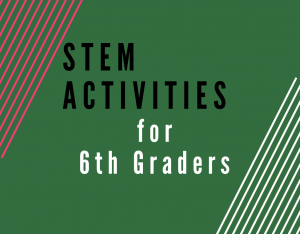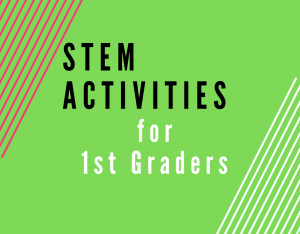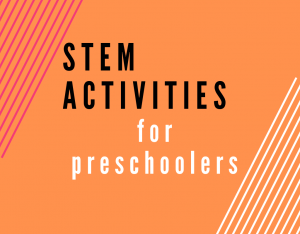Are you looking for STEM activities for eighth-graders? Because STEM is pretty new, this can be a difficult task. Many resources providing STEM activities don’t give enough information, while others have way too much information that it gets confusing. Resources that provide too little information usually have you trying to figure out the rest, hoping it turns out OK. The resources with too much information often attempt to explain all the teaching standards covered for a span of grades. This makes the STEM activities seem more complicated than they need to be and leaves you thinking twice about facilitating them.
I created this page to simplify things. I list projects that aren’t too difficult to facilitate, while still being effective in advancing STEM learning for eighth-graders. Each activity includes a materials list, a description, how to, STEM content, and what to say and ask.
Table of Contents
Calcium Chloride Chemistry
Materials
- matches
- wooden splint
- zip-lock plastic baggie
- small water bottle
- universal indicator
- sodium bicarbonate (baking soda)
- calcium chloride
- tape
- surface temperature sensor (fast-response)
- chemical toe-warmer (optional)
Description
Students begin this activity by thinking of observable changes that show a chemical change has happened. Then they mix water with calcium chloride and measure the change in temperature during the reaction. Next, they add baking soda to the calcium chloride and water mix and measure the change in temperature. Throughout, students are told to record observations that show a chemical reaction has happened. They are also asked to analyze the changes in temperature and determine if heat is produced or consumed during the reactions.
How To
In this experiment, two common household chemicals will be mixed, and several chemical changes will be observed. Calcium chloride is an ingredient in some types of products used to melt ice on sidewalks during the winter. Baking soda (sodium bicarbonate) is commonly found in most kitchens and is used for cooking. The third chemical that is used is universal indicator. Universal indicator changes color when the reaction involves an acid or base.
- Start by sticking the temperature sensor to the lower outside corner of a zip-lock bag. Note that touching the sensor will raise the temperature.
- Use your thumb and forefinger to pinch the zip-lock plastic baggie at the bottom to create two partitioned areas.
- Collect the temperature.
- Place one spoon of calcium chloride into the corner of the zip-lock plastic baggie with the temperature sensor attached.
- Put a spoonful of baking soda into the other corner of the bag. At this point, do not mix the two chemicals.
- Place about 30 mL of water and 5 drops of universal indicator into the calcium chlorine partition only. Make sure that the water does not touch the baking soda.
- Record the temperature change as the calcium chloride reacts with water.
- Record your observations that show that a chemical reaction is happening.
- Seal the bag.
- Take your thumb and forefinger off the baggie and mix the baking soda with the calcium chloride solution.
- Record the temperature change of the bag.
- Record your observations that show that a chemical reaction is happening.
- If you’re in a lab that allows open flame, ignite a wooden splint. Open the baggie and carefully place the blazing splint into the gas that was created during the chemical reaction.
- Put out the splint by running water over it.
- Rinse the baggie in the sink with lots of water and throw the baggie out in the trash.
- Note what you observe about the flame.
Science Content
- MS-PS1-2: Analyze and interpret data on the properties of substances before and after the substances interact to determine if a chemical reaction has occurred.
- NSES Physical Science – Chemical Reactions:
- Chemical reactions occur all around us, for example, in health care, cooking, cosmetics, and automobiles. Complex chemical reactions involving carbon-based molecules take place constantly in every cell in our bodies.
- NSES Physical Science – Chemical Reactions:
- Chemical reactions may release or consume energy. Some reactions, such as burning fossil fuels, release large amounts of energy by losing heat and by emitting light.
- Light can initiate many chemical reactions such as photosynthesis and the evolution of urban smog.
- NSES Physical Science – Structure and properties of matter:
- The physical properties of compounds reflect the nature of the interactions among its molecules. These interactions are determined by the structure of the molecule, including the constituent atoms and the distances and angles between them.
What to Say and Ask
- Did the reaction of the calcium chloride with water make heat or consume heat?
- The reaction that occurs in step 12 is
- CaCl2 (aq) + 2 NaHCO3 (aq) —→ 2 NaCl (aq) + 2 CO2 (g) + Ca(OH)2 (aq)
- List the chemical changes that this reaction displayed.
- Did the reaction in step 11 produce heat or consume heat?
- What gas was made during this chemical reaction? Why do you think so?
- Look at your initial list of observable changes that show a chemical reaction. What would you add to this list? What would you remove as changes that are not chemical in nature?
- If you were to measure the mass of the baggie and chemicals before sealing the baggie, and again measured the mass after the chemical reaction was finished, would the mass of the baggie and its contents increase, decrease, or stay the same? Why?
Source
https://ngss.nsta.org/Resource.aspx?ResourceID=166
Chemical Reactions
Description
Students observe the properties of substances before and after chemical reactions demonstrated by the teacher. Their observations are used to conclude the characteristics that define chemical reactions. They test their conclusions by comparing boiling water to the demonstration reactions.
How To
Explain to students that during each reaction, they need to write down as many observations that they can see. As we are trying to determine evidence that will determine if a reaction is chemical or physical, it is important for students to especially note any changes they see occurring to the involved substance properties.
It is also important for students to be aware of the safety and health hazards of the chemical being used in these reactions. Students must wear goggles and may not touch any of the products formed during the reactions. The teacher needs to read each chemical’s safety and health hazards to ensure that everyone is safe during these reactions.
Demo #1: Iodine O’Clock
Materials:
- mixture of ¼ tsp sodium sulfite and ¼ tsp citric acid
- stirring rods or spoons
- 3 beakers – 500 ml
- ¼ and ½ tsp measuring spoons
Procedure:
1. Pour ¾ cup water into the first beaker.
2. Stir in 1 starch pellet until it dissolves. It won’t dissolve entirely.
3. Stir in ¼ tsp sodium sulfite and ¼ tsp of citric acid mixture until they dissolve.
4. Pour ¾ cup water into the second beaker.
5. Stir ¼ tsp sodium iodate into the second beaker until dissolves.
6. Pour the first beaker into the second beaker.
7. Pour the mixture back into the first beaker.
8. Pour the mixture into a third beaker. Let students know that they shouldn’t take their eyes off it even if it looks like nothing is happening. Once the reaction has finished, have students write down their observations.
Demo #2: Rocket Power
Materials:
- Glycerine
- Manganese Dioxide
- Potassium Chlorate
- matches
- long eye dropper
- bunsen burner
- ring Stand
- test tube
Procedure:
1. Put a test tube on a rings stand at an angle over a Bunsen burner. Be sure not to point the opening of the test tube is at students.
2. Place about a tip of a scapula of Potassium Chlorate in the bottom of the test tube.
3. Place the same amount of Manganese Dioxide on top of the Potassium Chlorate.
4. Use a long eyedropper to place a few drops of glycerin on top of the Potassium Chlorate and Manganese Dioxide.
5. Light the Bunsen burner to supply heat.
It only takes a minute to develop. It’s almost ready to react once the smoke starts. After the reaction, have students write down their observations.
Demo #3: Fiery Toothpaste
Materials:
- matches
- wooden skewers
- food coloring
- Dawn dish detergent
- gloves
- saturated solution of Potassium Iodide
- 30% Hydrogen Peroxide
- 2 100 mL beakers or a 2 Liter bottle
Procedure:
1. Put gloves on to pour 80 mL of the 30% Hydrogen Peroxide into a large graduated cylinder.
2. Squeeze in about 30 mL of Dawn dish detergent.
3. Swirl the two around in the bottom of the container.
4. Drip in two different colors of food coloring at the corners of the cylinder. This will make it look like toothpaste.
5. Pour in 40 mL of the saturated Potassium Iodide solution.
6. Take a step back.
7. Once the reaction has finished, light the end of a wooden skewer and then blow it out so there are red embers left at the end. Lower the hot tip into the bubbles slowly to reignite the skewer!
Science Content
MS-PS1-2: Analyze and interpret data on the properties of substances before and after the substances interact to determine if a chemical reaction has occurred.
CCSS.ELA-LITERACY.WHST.6-8.1.B: Support claim(s) with logical reasoning and relevant, accurate data and evidence that demonstrate an understanding of the topic or text, using credible sources.
CCSS.ELA-LITERACY.WHST.6-8.2: Write informative/explanatory texts, including the narration of historical events, scientific procedures/experiments, or technical processes.
What to Say and Ask
- What are you going to learn today?
- How do particles combine into new substances?
- What proof can show how the chemical and physical properties of the substances change?
Source
https://betterlesson.com/lesson/634016/chemical-reactions-un-notes



